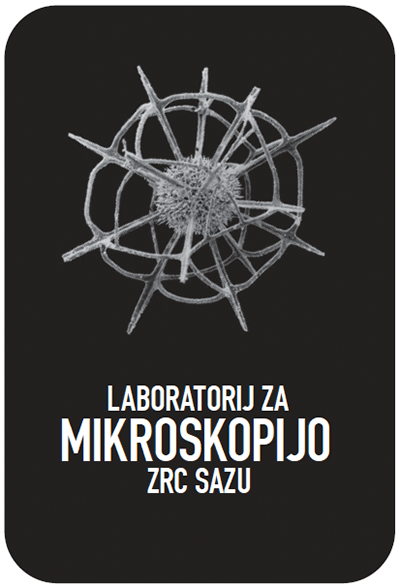Microscopy Laboratory

contact:
tim.cifer@zrc-sazu.si
t: 01 4706 375
[Tim Cifer]
The laboratory of electron and optical microscopy is designed to be highly multidisciplinary, serving fundamental and applied research conducted by researchers in the fields of palaeontology, geology, karst research, archaeology, botany, zoology, microbiology, and some areas of humanities.
The core of the lab* consists of an advanced model of compact yet versatile scanning electron microscope, JEOL JSM-IT100. The model configuration is full (all-in-one): the microscope operates in both high vacuum (HV) and low vacuum (LV) modes, equipped with a conventional secondary electron detector (SED), a backscattered electron detector (BED) for topographic, compositional, and shadow surface observation, an energy-dispersive X-ray spectroscopy (EDS) detector for qualitative and quantitative elemental chemical analysis, a secondary electron detector for low vacuum (LV SED), and an optional cathodoluminescence detector Jeol/Gatan Mini CL with a photomultiplier (CLD). The SEM can be fully controlled by a computer, with a touch screen, keyboard, and mouse, or with a traditional control panel. The software includes a package for 3D image analysis and surface roughness measurement.
An integral part of the electron microscopy system, particularly for sample preparation for elemental analysis with EDS, is a JEOL JEC-530 carbon coater, used for depositing thin conductive carbon films on samples, especially on polished sections that can be analysed under high vacuum and also examined under an optical microscope in transmitted light. The device's chamber allows for coating large samples with a diameter of up to 120 mm.
The optical microscopy facilities include an Olympus BX51 TRF-6 and an Olympus BX53-P optical polarising microscopes with a dual light source, designed for investigation in transmitted and reflected light. Both have a trinocular tube, exchangeable sets of objectives (x1.25, x4 x10, x20, x40, x100) and accessories for standard petrographic examination on a rotating stage. The polarising microscopes and two Olympus SZ6 / SZX6 stereomicroscopes are equipped with SC-50 and DP23 digital cameras, respectively, and are connected to personal computers with PRECiV and cellSens software packages. The SZX6 model is equiped with a polariser and an analyser for obesrvation in transmitted PPL and XPL modes.
* The core of the institute microscopy facilities, i.e. the project "Laboratory for Microscopy at ZRC SAZU", has been partially financed (2016) by the European Union through the European Regional Development Fund and the Ministry of Education, Science, and Sport. The operation was carried out within the framework of the Operational Program for Strengthening Regional Development Potentials for the period 2007-2013, in the developmental priority of "Economic Development Infrastructure" and the specific objective of "Educational-Research Infrastructure."



JEOL JSM-IT100 Scanning electron microscope

JEOL JEC-530 carbon coater

Olympus BX51 polarising microscope